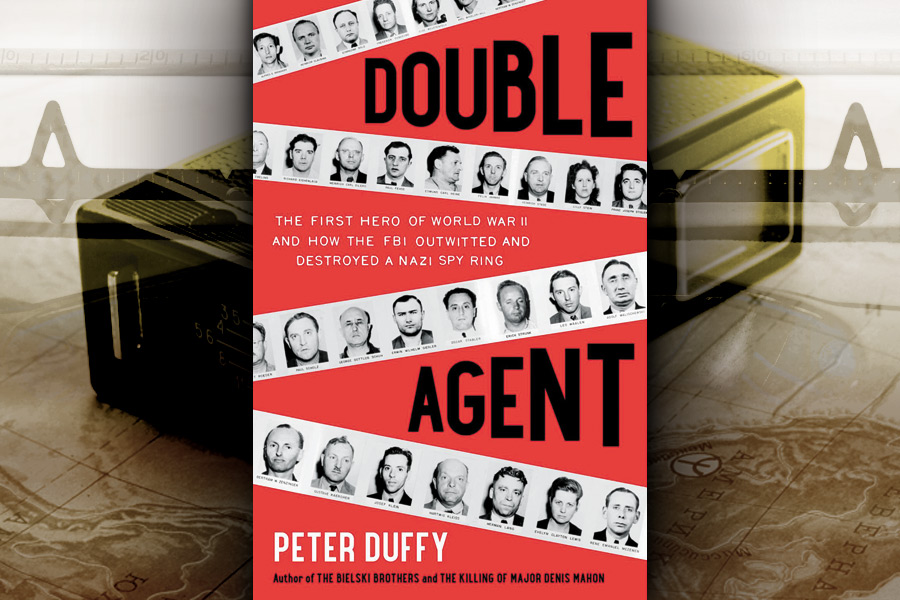By the Book: Adventures of a Secret (Double) Agent Man

In his book Double Agent: The First Hero of World War II and How the FBI Outwitted and Destroyed a Nazi Spy Ring, author Peter Duffy notes that the term “double agent” wasn’t yet in use when William G. Sebold, a mechanical draftsman who had served in WWI, agreed in 1939 to pretend to spy for German military intelligence (the Abwehr) while working for the Federal Bureau of Investigation (FBI). Born in Mülheim, Germany and naturalized as an American citizen in 1936, Sebold became the first counterspy in FBI history.
Naturally, Sebold was nervous at being given a fictional identity (Harry Sawyer), a pretend office in Times Square with a two-way mirror in place where he met with other spies and the task of transmitting phony messages to German control in Hamburg from an FBI-established short-wave radio station on the North Shore near Centerport. Sebold’s efforts, however, paid off. Duffy opens Double Agent on June 27, 1941, when 33 members of the Duquesne Spy Ring were rounded up and put on trial in Brooklyn Federal Court, the largest such case in American history. Convictions came on December 12, 1941—incidentally, the day after Hitler declared Franklin D. Roosevelt “an unsophisticated warmonger” and “mentally unsound,” and praised the Japanese attack on Pearl Harbor.
Double Agent is an important and impressively researched account of a still little-known man who made a big difference in the world of counterintelligence. Duffy reveals new information, much of it from thousands of pages of FBI documents, that sheds light on the phenomenal growth of J. Edgar Hoover’s FBI. Duffy also traverses less familiar history in his account of how Hitler used propaganda to convince Europeans and Americans that Czechs of German origin were being terrorized, justifying a German invasion.
Duffy also provides, as others have done, incontrovertible evidence of American hatred of Jews and Communists, which provided fertile soil for Nazi sympathizers and possible spies. The idea of German agents on American soil wasn’t so far-fetched.
One of the more absorbing sections of Double Agent is about how J. Edgar Hoover both encouraged and benefitted from fears about German agents in America. In 1939, the film Confessions of a Nazi Spy, starring Edward G. Robinson, beat out The Wizard of Oz and Mr. Smith Goes to Washington to become the National Board of Review of Motion Pictures’ Best Film.
Those of a certain age might also remember the 1945 film The House on 92nd Street, which was based on the Sebold operation—although in the film, the object of German interest was the atomic bomb, while in real life, it was the Norden bombsight (“a precious instrument of mythic reputation designed to turn modern airplanes into bomb-dropping systems of unprecedented accuracy”). In fact, by the time Sebold was recruited, the plans for the Norden had already been passed to the Germans—they just didn’t know what they had.
WWII military buffs will revel in Duffy’s accounts of the differences between American and German warplanes, but anyone who recalls the subject of Picasso’s Guernica will be horrified anew by descriptions of the indiscriminate strafing the Germans visited on that Basque village in 1937 during the Spanish Civil War. For younger readers, Duffy’s book may also elicit surprise and disbelief at the fact that the New York City area supported an extensive network of Nazi sympathizers, a Bund largely centered in Yorkville, along with “swastika waving, sieg-heiling and Hitler praising” summer assemblies at Camp Siegfried in Yaphank.
Although Duffy’s subject matter is both timely and significant, one wishes for a more compelling narrative. At times the detail becomes a bit much, especially the bios and activity timelines of secondary players. And then there is Sebold himself, an unlikely and unengaging hero. Though the first double agent in Bureau history, and from all accounts an American patriot, he emerges as a less-than-attractive man with multiple and recurrent maladies. (He died, relatively unknown, in an early version of the witness protection program, with repeated health problems and financial woes.) Here, too, however, it could be said that Sebold was the kind of unemotional and passive person the FBI wanted—they didn’t need a Hollywood action hero. They needed a double agent.



